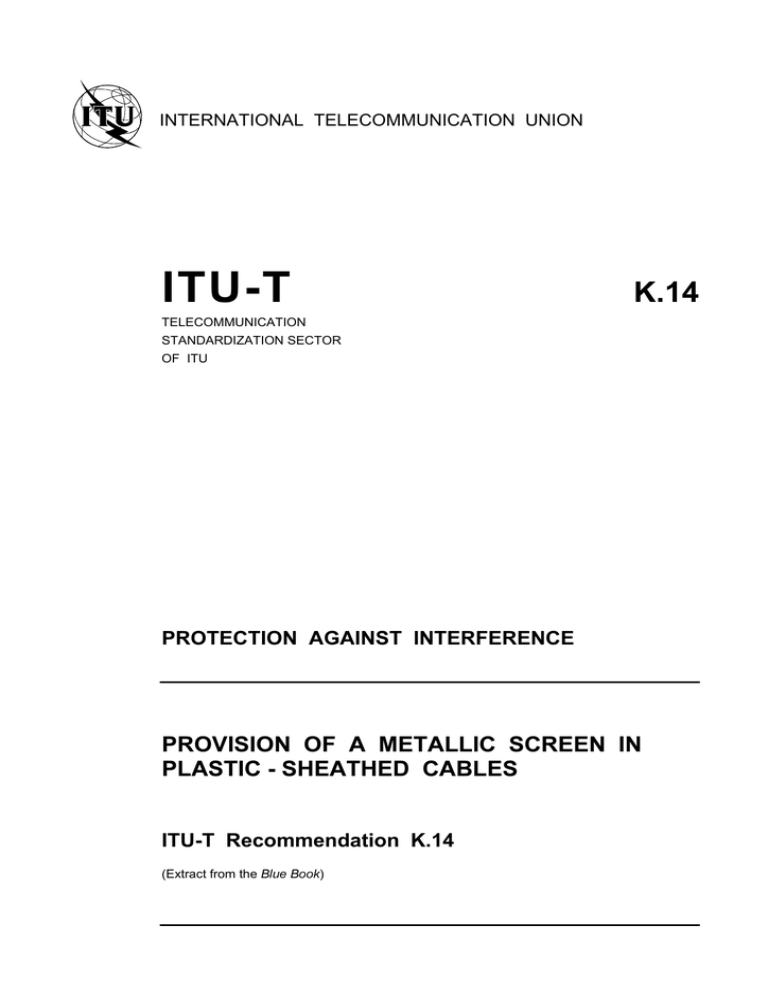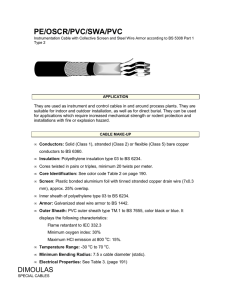
INTERNATIONAL TELECOMMUNICATION UNION
)454
+
TELECOMMUNICATION
STANDARDIZATION SECTOR
OF ITU
02/4%#4)/. !'!).34 ).4%2&%2%.#%
02/6)3)/. /& ! -%4!,,)# 3#2%%. ).
0,!34)# 3(%!4(%$ #!",%3
)454 Recommendation +
(Extract from the "LUE "OOK)
NOTES
1
ITU-T Recommendation K.14 was published in Volume IX of the Blue Book. This file is an extract from the
Blue Book. While the presentation and layout of the text might be slightly different from the Blue Book version, the
contents of the file are identical to the Blue Book version and copyright conditions remain unchanged (see below).
2
In this Recommendation, the expression “Administration” is used for conciseness to indicate both a
telecommunication administration and a recognized operating agency.
ITU 1988, 1993
All rights reserved. No part of this publication may be reproduced or utilized in any form or by any means, electronic or
mechanical, including photocopying and microfilm, without permission in writing from the ITU.
Recommendation K.14
Volume IX - Rec. K.14
PROVISION OF A METALLIC SCREEN IN PLASTIC-SHEATHED CABLES
(Geneva, 1972; modified at Malaga-Torremolinos, 1984)
A metal sheath provides a cable with electrostatic screening and a degree of magnetic screening. A plastic
sheath has no intrinsic screening properties. Some plastic-sheathed cables, for example those with paper-insulated
cores, incorporate a metal screen as a water barrier. Such a metal screen, which is usually in the form of a
longitudinally applied aluminium tape, provides the same screening properties as a nonferrous metal sheath of the same
longitudinal conductivity. The tape must, however, be connected to the telephone exchange earth electrode systems at
its ends and/or to conveniently located earthing points, such as metal cable sheaths, along its length. It is also important
that at jointing points the tape be extended through by connections of very low resistance. Although the degree of
screening provided by the tape may be small at 50 Hz, it can be considerable at frequencies which give rise to noise
interference. The presence of a screen on a cable also reduces the induction arising from the high-frequency
components of transients caused by power-line switching and also induced transients from lightning strokes; such
transient induced voltages are of increasing importance with the increasing use of miniaturized telecommunication
equipment with very small thermal capacity.
On the basis of the above considerations and experience with the use of plastic-sheathed cables,
the CCITT recommends that the following provisions be observed:
1
Since plastic-sheathed subscriber distribution cables without a screen give satisfaction for distribution from the
exchange to subscribers, they may be used in localities where there are no alternating current electrified railways.
However, account must always be taken of the risk of noise interference that may arise in the vicinity of electric
railways, especially those with thyristor controlled equipment in the locomotives. Consideration should also be given to
possible interference by radio transmitters which operate in the same frequency range as the circuits in the plasticsheathed cable.
2
Trunk and junction cables should contain a screen which can have the form of an aluminium-tape water barrier.
Cables provided with a screen having a conductance of the order of half that of a cable having the same core diameter,
but with a lead sheath, have given complete satisfaction where there are no risks of severe magnetic induction.
3
If a plastic-sheathed cable is provided with a screen of a conductance equivalent to that of a conventional leadsheathed cable, then in the presence of induction the plastic-sheathed cable can be used in entirely the same
circumstances as the lead-sheathed cable.
4
If the effect of the screen according to §§ 2 and 3 above is not sufficient to limit the magnetic induction at
mains frequencies, or to these harmonics arising from neighbouring power lines or electric railways, to permissible
values the screening factor can be improved by increasing:
4.1
the inductance of the metal sheath, if necessary, by a lapping of steel tapes;
4.2
the conductance of the existing screen by additional metal tapes or wires which are arranged below the screen.
An improved screening effect may also become necessary if there is the risk of noise interference in the vicinity
of electric railways equipped with thyristor controlled devices.
5
The screen must be connected to the earth electrode systems of the telecommunication centres. In the case of
subscribers' cables the remote end should be connected to a suitable earth. It is also important for the screen of the
cable to be extended through at cable joints by means of connections of very low resistance.
6
In view of the increase in the number of electrical installations and the level of harmonics resulting from new
techniques, it is to be expected that the effects of interference will become worse. This being so, it may be extremely
useful to improve the screening effect of plastic-covered cables as indicated above.
7
If cables have to be laid in areas where there is a danger of atmospheric discharges, attention is drawn to the
importance of the metallic screen and of its construction in the protection of cables against lightning and also to the
importance of the interconnections between the screen and other structures. (See the manual cited in [1].)
Volume IX - Rec. K.14
1
8
Screening factor
The following considerations enable the screening factor at the mains frequency to be determined fairly
accurately for all types of cable regardless of the outer plastic covering used. In particular, they show how the
screening factor to be used in practice may vary depending on the conditions in which the cable is used.
8.1
General
The screening effect produced by the metal screen of a cable mainly depends on:
8.1.1
−
the frequency of the induced e.m.f. The limitation of this e.m.f. mains frequency (16 2/3 Hz, 50 Hz, 60 Hz)
is therefore a determining factor in the choice of a cable from the standpoint of safety of staff and
installations. On the other hand, the screening factor at higher frequencies should also be taken into account
in seeking to protect equipment against interference. A substantial reduction of the induced e.m.f. at the
mains frequency may suffice for complete protection;
−
the level of induced e.m.f. per unit length in the case of screens made by ferromagnetic material. The
screening effect of such a cable is optimum for a given value of induced e.m.f. per unit length, so that a
cable designed for the reduction of high induced e.m.f. per unit length may be of no practical use for
protection against low induced e.m.f. per unit length. The composition of the screen must be adapted to the
level of the induced e.m.f. per unit length;
−
the quality of its earthing. The screening effect is determined by the value of the current circulating in the
metal screen. The resistance of the parts ensuring current flow between screen and earth is therefore
decisive. For cables with an insulating plastic outer covering, if earth connections are provided only at the
ends, they must be of very low resistance: the sheath should preferably be earthed at intervals along the
line. When the plastic outer covering is conductive, the sheath is in practice continuously earthed;
−
the length of the induced section of the link to be protected. It is easier to improve the screening effect
when this section is long. The concept of length in this case relates to the quality of earthing required.
The screening factor (for explanation of symbols, see Appendix I)
The following most frequently used screening factors are defined in the Directives:
2
−
Nominal screening factor, kn (see Figure 1/K.14). This factor can easily be measured in a laboratory and is
used to qualify the efficiency of the screening effect.
−
Screening factor related to distant earth, kƒƒ' (see Figure 2/K.14). This factor must be taken into account in
ensuring protection against danger and interference, the conductors of the subscriber pairs being connected
at their terminals to a neutral earth through certain parts of the equipments, without transformers.
Volume IX - Rec. K.14
−
Screening factor related to the sheath kƒm (see Figure 3/K.14). This factor must be taken into consideration
in cases where the only accessible earths are those used for earthing the screen. This relates to cables
connecting telecommunication centres to one another, their screens being connected to the earths of the
centres.
The Directives contain very detailed explanations and formulas for the accurate calculation of these factors in a
wide variety of situations. On the other hand, these screening factors can be evaluated on the basis of simple
expressions which often provide an adequate degree of accuracy. These expressions differ according to whether the
outer cable covering is insulative or conductive and use the constants and variables listed in Appendix I.
8.2
Cables with insulating outer covering
The outer covering of the metallic cable sheath is made of an insulating plastic material. To obtain a screening
effect, this sheath must be earthed at both ends and possibly at points in between.
Volume IX - Rec. K.14
3
8.2.1
Calculation of the screening factor
The screening factor can then be calculated by means of the expressions (see also the Directives, Vol. II):
kƒƒ' =
ZiE L + WA + WB
ZeE L + Zs L + WA + WB
(8-1)
kƒm =
ZiE L
ZeE L + Zs L + WA + WB
(8-2)
Strictly speaking, the use of these expressions presupposes that the sheath is earthed only at the ends. It may be
assumed, however, that in fairly comparable situations only the earths near the ends have any influence on the
screening effect. The expression thus gives a good approximation of the screening effect in the case of intermediate
earths.
As a general consequence, earthing connections at intermediate points tend to improve kƒƒ', but, on the other
hand, make kƒm worse.
8.2.2
Influence of length
When the earths of a sheath required to obtain a screening factor kƒƒ' close to nominal value kn have a
resistance value which makes earthing very difficult, the link may be considered to be “short”. In the contrary case, it is
regarded as “long”.
Note – “Link” is held to mean the cable length actually subjected to induction.
8.2.2.1 “Long” links
Scrutiny of Equations (8-1) and (8-2) shows that for very long links, screening factors kƒƒ' and kƒm are close to
kn. This is true of lengths in excess of about
10
WA + WB
ZiE
In this case, a non-armoured cable ( ZeE close to ZiE ) may be used. Moreover, the longer the link, the higher
the resistance value of the sheath earthing may be.
This need not be taken into account in the choice of a cable, which can be based on the curve of values of
nominal screening factor kn for different values of induced e.m.f., since the efficiency obtained will be very similar.
8.2.2.2 “Short” links
In this case, the value of ZiE L is approximately the same order of magnitude as the sum of the extreme terminal
earth values WA + WB . Screening factors kƒƒ' and kƒm may be calculated by means of Equations (8-1) and (8-2).
Armoured cables must be used to protect such links, and the screening effect is then provided through the
increase in the value of impedance ZeE obtained by using material with high magnetic permeability for the outer part of
the sheath.
4
Volume IX - Rec. K.14
To evaluate kƒƒ' and kƒm by means of Equations (8-1) and (8-2), it is necessary to know the curve of variations
of ZeE as a function of the current flowing through the sheath (Figure 4/K.14).
The calculation then calls for some simple successive approximations for evaluating ZeE after choosing a value
of W A and WB corresponding to earths which may be expected to be feasible in view of the ground resistivity at the
ends of the link.
8.3
Cables with conductive outer covering
The outer covering of the metallic cable sheath is made of a conductive plastic material providing electrical
contact between the sheath and the earth surrounding the cable.
Intermediate connections of the sheath to the earth other than at the ends will be unnecessary if the resistivity of
the conductive material is close to or better than that of the surrounding earth (values of about 50 Ω ⋅ m are easily
obtained).
The current flowing through the sheath varies along the link, particularly near the terminals, and in the middle
part remains at a value very close to IM = e / ( ZeE + Zs), corresponding to the current which would circulate in the
sheath if it were completely earthed (earths with zero resistance value).
To calculate screening factor kƒƒ', we can thus use an equivalence consisting in replacing this cable by one with
a sheath connected to the earth at each end by zero resistance earths and of a length equal to that of the link L,
shortened at each end by a length l such that P l = 1.
This means that the cable has a nominal screening factor on a shorter length equal to L – 2l.
kƒƒ' can then be evaluated approximately by means of the following expression:
2l 2l
k ff ’ = kn 1 − +
L L
(8 - 3)
Volume IX - Rec. K.14
5
In the same way, kƒm can be expressed by:
2l
k fm = kn 1 −
L
Equation (8-3) is not applicable in cases where the earthing of the metallic sheath is really excellent. The link is
then considered to be “long” and kƒƒ' = kƒm = kn.
(
)
The parameters required for the calculation are those of the cable ZeE , ZiE , the induced e.m.f. per unit length
and the admittance per unit length Y of the sheath in relation to the earth, which may be chosen according to ground
resistivities between 1 S and 10 S (1 S should be chosen if nothing is known about earthing quality).
8.3.1
Influence of length
The remarks relating to cables with insulating covering are also applicable in this case.
8.3.2
“Long” links
The screening factor is close to kn. The cable may or may not be armoured, according to the results required.
8.3.3
Short” links
Screening factor kƒƒ' may be estimated by means of Equation (8-3). The cable should be armoured in most
cases.
8.4
Determination of cable parameters
If the nominal screening factor and impedance per unit length Z iE can be measured by means of the
arrangement described in the Directives (Vol. IX), determination of impedance per unit length Z eE can be based:
−
either on a calculation based on the phaser diagram, plotted from the measured parameters I, Uoi and Uoe;
−
or on the measurement of the voltage Uoe appearing between the end of a conducting wire laid on the
outside of the sheath and reference point 3, the other end of the wire being connected to the sheath
(Figure 5/K.14).
For certain cables with screens consisting of several non-ferromagnetic, highly-conductive layers, these
parameters can be measured more approximately by a coaxial-type measuring device.
6
Volume IX - Rec. K.14
ZiE :
Internal impedance per unit length with external return. For power frequencies, this value is close to
resistance per unit length for direct current.
ZeE :
External impedance with external return per unit length.
Zs :
Ground return impedance per unit length.
Y:
Admittance per unit length of the sheath-earth circuit.
P:
Propagation constant of the sheath-earth circuit.
K:
Characteristic impedance of the sheath-earth circuit.
WA ,WB : Impedance value of earths at the ends of the sheath.
L:
Length of link subject to induction.
e:
Induced e.m.f. per unit length.
E:
Total induced e.m.f.
I:
Current flowing through the sheath.
Reference
[1]
CCITT manual The protection of telecommunicaton lines and equipment against lightning discharges,
Chapter 4, § 2.1, ITU, Geneva, 1974, 1978.
Volume IX - Rec. K.14
7


